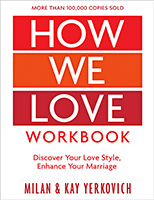Milan & Kay Yerkovich, in their book titled, “How We Love”, have identified four love styles that impair how we love others, especially our spouse. They are: The Avoider Style, The Pleaser Style, The Vacillator Style, and The Chaotic (Controller & Victim) Style.
Last month we examined how crucial our early childhood experiences are and how they impact how we give and receive love even today as adults. This month we will be looking at the first two love styles that come from our impaired emotional connections as children and young adults.
The Avoider Love Style
The Home Environment
Parents of avoiders often find a child’s needs and emotions overwhelming and irritating, so they unwittingly teach their children not to “cause a scene”, to ignore their feelings, and to downplay their needs. Faced with emotionally unavailable parents, children learn that independence pleases parents and begin looking for ways to prove how well they can take care of themselves just as their parents did. Tragically, having fun and enjoying the wonder of childhood are foreign and threatening concepts to these parents.
What’s it Like to Be the Kid?
Children raised like this type rarely, if ever, receive comfort when they are upset, especially as they get older. Babies may be indulged, but by the toddler and preschool years, the child’s distress is likely to be met with resistance. Children with an avoider imprint are shut down to their emotions and needs, often feeling a vague sense of emptiness. These children learn early on to hide their needs under a convincing surface of independence, asking little from others and keeping their disappointment submerged.
IMPRINTED WITH AN AVOIDER LOVE STYLE
| Child’s Needs | Child’s Expression | Parental Response | Child’s Reaction | Avoider Characteristics |
|---|---|---|---|---|
| Overwhelming to parents, or parent shows disinterest | Stifled and/or limited by parent | Parent encourages limited expression of emotions and does not comfort | Child restricts emotions and needs, and becomes independent | Avoids emotions and needs of self and others |
Common Phrases of Avoiders
“I’m Just Not a Big ‘Feeler'”
“What’s So Great About Comfort?”
“I Don’t Want to Talk About It”
“Just Give Me Space”
“I Don’t Need Your Help”
“I’ll Take Care of It”
“I Get the Job Done”
“I Don’t Cry”
“Only Weak People Feel Scared or Sad”
Growth Goals
If you relate to the avoider imprint, you might be thinking, Darn it! I was sure my spouse was the problem! Well, quit blaming your spouse, admit you’re part of the problem, and take responsibility for your contribution. And if you are married to an avoider, don’t take his or her stoicism personally. “I’m fine” is a favorite phrase of avoiders, but when you avoiders think about it, you know you’re not. You may have survived childhood by detaching from your feelings and needs, but now you’ve escaped and you have a challenge ahead. You’re going to have to surrender to the process of change and be willing to recognize your injury instead of insisting that your childhood was just “normal kid stuff”. The book and workbook has additional growth goals to help you build intimacy in your marriage and help your spouse learn how to respond in healthy ways to your avoider tendencies and thereby encourage a more secure love style.
The Pleaser Love Style
The Home Environment
Parents of pleasers are often overwhelmed due to their excessive worrying. Fearful parents need control in order to minimize risk. Instead of helping their child accept, process, and manage negative feelings, these parents attempt to rescue their child from having to experience such feelings at all. Pleasers also are created when an angry or critical parent dominates the scene, and a feeling of apprehension pervades the home. In such cases, some children keep trying to please and win the approval of the faultfinding parent, while others learn to “walk on eggshells” to avoid an angry outburst.
What’s it Like to Be the Kid?
Children raised by fearful, angry, or critical parents become fearful themselves. Children may take on the pleaser role to reduce tension and anxiety in adults and, ultimately, in themselves. In overprotective homes, children may become fearful, clingy, and hypervigilant about possible danger. These kids learn to read and respond to the distress they perceive in others. These kids can also learn to monitor their environment and attempt to fix problems as they arise to avoid potential stressful situations.
IMPRINTED WITH A PLEASER LOVE STYLE
| Child’s Needs | Child’s Expression | Parental Response | Child’s Reaction | Pleaser Characteristics |
|---|---|---|---|---|
| Causes parental fear and anxiety, or parent is critical | Causes internal and external parental alarm, or parent is overly critical | Parent worries, overprotects, smothers, or is critical and expects too much | Child develops fears, worry, anxiety, and clinginess or performance anxiety | Reduces anxiety by pleasing others |
Common Phrases of Pleasers
“I’m Not Worried, I’m Just Stressed”
“I Just Want to Be with You”
“I’m Only Trying to Help”
“How Am I Doing?”
“Whatever You Decide”
“Don’t Get Mad, I’m Only Trying to Be Nice”
“If Things Stay the Same, I Know What to Expect”
“Everybody Wants Too Much”
What Do I Want?”
“Aren’t You Scared?”
Growth Goals
If you identify with the imprint of a pleaser, the driving force behind your interactions is anxiety and fear. One of the first steps of healing is just acknowledging that much of the time you are anxious and/or fearful. Recognizing that you are anxious and fearful of people’s responses can take some time, after all, you may have lived this way for so many years that it just seems normal to you. Wanting to please people and avoid conflict can cause you to suppress your own feelings and needs and focus on giving to others at your own expense. Determine to be more honest about your feelings and assertive about what you need. Learn to tolerate others not being pleased with you or even angry with you. You are not responsible for your spouse’s anger. You don’t have to fix it.
If you are married to a pleaser, Keep in mind that the primary difficult emotion for pleasers is anxiety. Develop compassion for the pleaser’s anxiety by understanding the childhood experiences that contributed to the problem. Encourage them to explore feelings, such as sadness and anger, that may underlie their anxiety. When pleasers make an effort to face their fears, offer acceptance and assurance. Encourage pleasers to stretch beyond their comfort level.
There are many more exercises and suggestions in the book and workbook to help you move from being an avoider or a pleaser to a more secure love style. If you have identified with either of these impaired styles, I recommend you did deeper by reading the book and workbook.
Next month we will look at the last two impaired love styles, vacillator and chaotic.
This month’s post is adapted from the book, “How We Love” by Milan & Kay Yerkovich. They also have a companion workbook to help you bring lasting change to your marriage relationship through exercises and questions that did deeper into the principles shared in the book. If you want more than insight and head knowledge, I recommend reading the book and going through the workbook with your spouse. You should get one workbook for each of you since you will be filling it out and have different answers.













Leave A Comment
You must be logged in to post a comment.